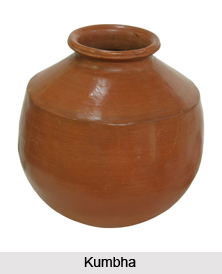 Kumbha are water pots which gained prominence in the ancient ages. The origin of these water pots is traced back to the Indus Valley Civilization. These vessels were made of heavy copper.
Kumbha are water pots which gained prominence in the ancient ages. The origin of these water pots is traced back to the Indus Valley Civilization. These vessels were made of heavy copper.
Functions of Kumbha
Kumbha were used to carry or store water. By burying them in the ground, these earthen water pots could also be used for keeping water cool. These vessels were also used for Vedic sacrifices.
Design of Kumbha
The shape of the Kumbha resembles natural objects like pumpkins and gourds. These were adapted to be functional by balancing them on the head, for carrying on the hip and for storage in the kitchen. Therefore, Kumbha had an exclusive design that was governed by functionality.
Placement of Kumbha
These kumbha or water pots were expected to be placed in a line on the west side of a kitchen, according to the Shivatattvaratnakara.
Other Water Vessels
Apart from Kumbha, another functional water vessel is the bhrangara with crossed straps. It was used by every Buddhist monk. These water pots are also mentioned in the old Tamil literature. It is mentioned as versatile water pots like the kallam and kundam. In addition to that, lota-shaped vessel with a long spout rising from the base was also found that suggested pouring function. All carrying water pots were provided with narrow mouths to prevent spillage. The pots used to be suspended from the roof in a rope sling (shimili) or kept in stands called pattadai, shumudu or shum-madu.
This article is a stub. You can enrich by adding more information to it. Send your Write Up to content@indianetzone.com
Related Articles:
Types of Indian Crafts
Clay Crafts of India
Kumhar
Clay Crafts of Kutch
Mangalghat
Lakshmighat






